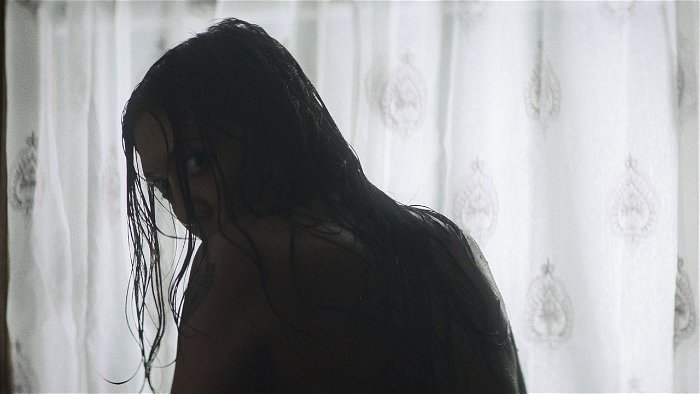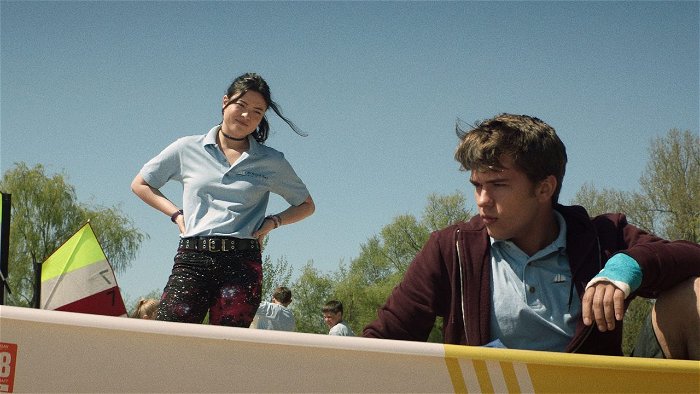The horror genre is filled with vastly different styles of movies, from the slick Hollywood productions to gritty and interesting indie films.
They all add to the medium, providing new takes on classic monsters and creatures. Whether witches or the undead, there are countless ways to tackle each concept and use ever-changing technology to bring these nightmares to life.
With their dad knee-deep in horror, working as the effects artist on the original Evil Dead, Brett Pierce and Drew T. Pierce grew up with genre cinema and the indie methods used by Sam Raimi back in the ’80s. The world of horror films was different back then; practical effects were king, and if you could not find a way to do it in reality, it would not make it into the movie. It is this mentality that the brothers brought to their latest film, The Wretched, a throwback creature-feature that rewinds filmmaking to the glory days—filled with blood, kids in danger, and plenty of gruesome practical effects.
Fueled by passion and a drive to create, they discussed with CGM what it took to make this film a reality. From inception to execution, the story of how it all came together is almost as interesting as the film itself. The Wretched is a blast to watch and sitting down over Skype, it is easy to see how these young filmmakers brought this vision to life.

CG Magazine: It seems like The Wretched wears its inspiration on its sleeve. Could you discuss some of the influences involved, how they made their way into the film, and how you surpassed them to make something uniquely your own?
Brett Pierce: A lot of Drew and I’s influences come from horror films, but also other types of movies. There’s obviously an ET influence. It’s not 100 per cent intentional sometimes, but I think it just happens because we both love ET so much.
Drew T. Pierce: I think one of the biggest influences is that we grew up with our dad, and he did the special effects on Evil Dead. We grew up with the mythology of the Evil Dead crew, and the hard shoot in their movies.
BP: Yeah. Evil Dead is a huge influence on us. Just because we were brought up with the idea that like if you want to make a horror movie, you get your friends together and you go out in the woods and you make a horror movie. It’s just because as kids there would be all these guys piled into our basement to finish the special effects in the movie. It instilled in us, “Oh, to make a movie all you have to do is invite your friends to come to your house. And then you go out in the woods and shoot stuff when you need it.”
DP: I think the way we tried to go beyond those influences is that our favourite horror movies usually have some sort of tie-ins in the theme that’s really interesting. The story ties into a theme with the creature, and the one we fell in love with that nobody was doing was the idea of witches, the dark mother, the anti-family creature. We’re like, “Well, that’s perfect.” That creates a story where it’s about a family that’s struggling to stay together. Meanwhile, you have this witch that’s trying to rip them apart at the same time.
BP: Yeah. One of our favourite films is the original Halloween. I mean, half the reason we wanted to shoot the movie on anamorphic lenses was because of the original Halloween. It’s one of those bratty elements as directors where your producers say you can’t shoot on anamorphic lenses. And we were just watching Halloween the night before. So, no, there’s no way we can’t shoot on anamorphic lenses, without that the movie’s going to be terrible.
DP: And we’re obsessed with John Carpenter’s The Thing.
BP: Yeah, The Thing, which has its influences on [our] movie somewhat with the witch taking the form of the mom next door. It’s funny, you don’t really realize what your influences are going into it until… we literally finished the movie two weeks ago!
I’m not joking. You sit down, you watch it, and then you’re like, man. It’s really apparent what I like, but it’s just really funny. It was honestly more for us. Drew and I just really wanted a movie about mythology and folklore as the backdrop for our supernatural element. We wanted to take characters and create a really good drama with people we cared about that we related to because we came from a divorced family. We wanted to build on top of that, and express some of our feelings through the movie. I always liked it in horror movies where you have the real people while their life is going on. Then the supernatural element comes in from the left and just crashes into it and destroys everything.
DP: It sort of tests all those relationships, like in Poltergeist.
BP: Poltergeist is a huge influence too.

CGM: You mentioned folklore, how did you come up with the concept of the witch and how she functions? Did you draw on actual folklore for The Wretched, or is this all from you?
BP: It’s a little bit of both, it actually comes from-
DP: It’s a hybrid from a lot of different mythologies.
BP: The inspiration comes from where we shot in northern Michigan, which is, to people that live in Michigan, where everybody goes on vacation. They go camping up north, we just call it “going up north.” Drew and I used to go up north and go camping in Traverse City. And there’s a lot of myths up there about witches like the Ada Witch, which is this weird spectre that appears on the side of the road, and all this other stuff. We were always obsessed with that type of creature storytelling, and we just wanted to figure out how to make our own new take on the witch movie and tell a new creepy fairy tale. So we started researching all these different witches from around the world from Black Annie and the Kali-ac to Jenny Greenfingers, all these things. And we saw some elements that were in all of them, so we cherry-picked to make one that really works for the story we want to tell. I really like this element about the witch in this story. If we tie this into that, it all makes sense. We weirdly cobbled it together from a bunch of different sources, all actual myths. But, the main ones that came from? Black Annie was a big influence originally.
Then there’s the Boo Hag, which I think is a southern myth. The story goes that this woman seduces a man and then she marries him. At night, she goes out and takes off her skin and seduces other men. Eventually, the husband realizes that she is going out at night and finds her skin in the closet and salts it. When she comes home, she puts it back on, and she burns. You know, these cool, weird myths. I haven’t seen anything like that in a film.
DP: I mean, there aren’t a lot of good witch movies, but in recent years, it feels like most of them are a ghost that they just call the witch. It’s a woman, maybe all her children were murdered, and she’s going to come back and wants revenge or wants to collect the bones of her children or something like that. We were more like, “I love witch mythology, but let’s give her a few rules and build her like you would a vampire or something like that.”
CGM: Let’s talk about the practical effects used in The Wretched. You had some great scenes and some great use of design that really captured the concept you’re trying to get forward. Why the choice to go practical for most of the stuff rather than going straight up CG? I mean, I know why I’d do it, but I’m curious.
BP: It just looks better. It’s probably exactly the same reason you would.
DP: I think people on set can react to it. You can’t put a price on that. Just the fact that if somebody’s staring at a green screen… I mean, we’re buds with Bruce Campbell, and he complains about it all the time.
BP: He was actually telling us the other day how much he doesn’t like doing kicks in front of green screens, and stuff like that.
DP: And we’re just huge fans. I mean, we told you that The Thing was such a touchstone for us, like with him. Our special effects guy just killed it.
BP: Yeah, his name was Erik Porn from this company called Bitemares. Drew and I grew up on practical effects, and they captured light the right way. Like Drew said, people can actually react to what’s there.
DP: There’s a magic trick quality to it when you see something and you don’t know exactly how it’s done. Practical effects are usually meant for the 3-10 seconds that they show up on the screen, and if you show it for one frame longer, it’s going to look like junk. That’s the magic trick, it’s fun to watch a movie and not know how something’s done. Whereas, if it’s CG, there’s just sort of this feeling of “every shot is a CG effect”. You’re just like, “Oh, that’s just a model or something. They just plugged into a computer.
BP: Yeah, and they’re also cool because we actually storyboarded—well, Drew did, then I worked with him in our DP and we storyboarded the whole movie. I think a lot of the challenges with practical effects, why people decide not to do them off the bat, are because you absolutely have to decide what you want to do it ahead of time because everybody’s got to know exactly what they’re looking at. I hear special effects guys complain about this all the time. They get asked to make something, and then they decide to shoot it from a completely different angle where it just doesn’t look good.
DP: It’s scary because you show up and the day of you have some sort of puppet or something that looks goofy, and you’re like, “How are we going to make this work? Like, we have a plan?” Sometimes it just doesn’t work.
BP: I would even say that I’m really proud of the practical effects. Like Drew was saying, some of them you see on screen and you’re like, “Man, it looks really awesome.” That’s for the three seconds you see it, but I guarantee you we cut at the fourth second because then it looked goofy. I think Drew and I especially get a kick out of old fashioned tricks with movies, from practical effects to forced perspective to anything because if you’re actually shooting it in the camera, it feels more real. It helps with the tension of the movie. It’s like you actually feel fear if you think that thing’s really there in the room with somebody.
DP: It’s so fun too. There’s something about the excitement of setting up a practical effect and having it work.
BP: Yeah, the whole crew comes around and they’re all like, “Oh, we’re about to spurt blood all over the place,” and you look at your effects team, and they look really happy.
DP: I can’t imagine shooting a horror movie on a green screen. It would be so boring.

CGM: I want to ask about the dynamic of the kids in The Wretched, because you have a very mature story but you’re telling it from the point of view of teenagers. Why that choice? How did you come up with a story about kids, almost a coming of age story-type thing, but also be about family and all this other stuff that makes up the movie?
BP: I think what that was, is that some of those decisions have a lot to do with how we grew up. Growing up in a divorced family and being put in a similar situation as Ben was in a lot of ways. I think there’s just something inherently scary about the notion that you can be discredited if you’re a teenager. If you’re grown up, that sort of makes everything a little bit less scary a lot of the time, because you’re just more capable. I feel like the kids, the less capable, are dealing with the worst situation—and getting anybody to believe that they are.
With a teenage character, Ben, it’s also at that time when you’re just getting your driver’s license, and you’re being trusted like almost half of an adult. It’s a time that you’re trying to prove yourself the most to your dad and your mom and be trustworthy. But it also tends to be the time that you act out the most, and you act the most ridiculous or be untrustworthy in some aspects. It created a good opportunity of presenting a point where he should be able to be trusted by his family. But, because of where he’s at, it’s very easy to see him as somebody that might be acting out or has outside problems influencing him and he’s acting unreasonably. That really helps with discrediting our main character. So he doesn’t just go like, “Hey, dad, guess what? There’s this horrible thing happening. It’s awful. It’s real.” His dad goes, “Oh, yeah, let’s go check it out. Yeah, you’re right.” Movie’s over.
CGM: Awesome. Let’s get into the level of violence, the level of horror, and the nature of it almost becoming a fun film at times. Even then, you also have those elements of terror and straight-up gore. How did you draw the line of how far to bring it? How far to push it? How do you know when to bring it back and make it a little bit more fun?
DP: I think it’s always a challenge. You know, I think it’s just our sensibilities. Like, we think it’s hard for us to get too dark. We joke that we always hear like, “Oh, there’s this fun scene in your movie.” We’re like, “Oh, we kill almost everybody in our movie.”
BP: Drew’s terrible at dropping ideas that I don’t want people to know. Yes, it’s a thing where, like, I think the contrast of something being perceived in the movie as very disturbing or dark is even better if you have levity and comedy and fun moments elsewhere. I see horror movies all the time. And I like some very, very dark horror movies that stay in the same tone all the way through. But I feel like if you’re just dark all the way through, it dulls things later in the movie because you’re staying in the same spot the whole time.
DP: So you always need that second to breathe and laugh. A light-hearted moment, even a slightly light-hearted moment, can release the tension so that it can build up again.
BP: I just like the idea that we have some elements of comedy in the film, But we also go to really dark, dark places, because I think that makes it more shocking and more entertaining, because you’re like, “Oh man, I’m really enjoying what’s going on with these characters,” and then you’re like, “Oh my gosh, what did you just do?”

CGM: Awesome. Thank you so much. Is there anything else you want to add that I didn’t touch on that you think the audience should know about when looking at The Wretched?
BP: I guess in some ways; I’d like to tell everybody it’s a very independent movie. It’s something that Drew and I took around town trying to get made. We live out in LA, but we’re from Michigan originally. We really wanted to make this movie and almost got it made a couple of times with a couple of companies, and then we just decided to strike out on our own because we felt so good about the movie we just wanted to make it the way we wanted to.
To read the full interview, please pickup CGMagazine #37 online, or at your local magazine retailer




